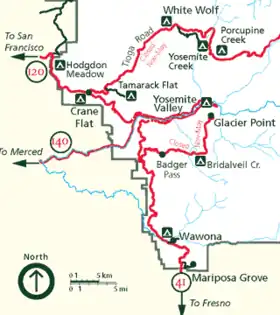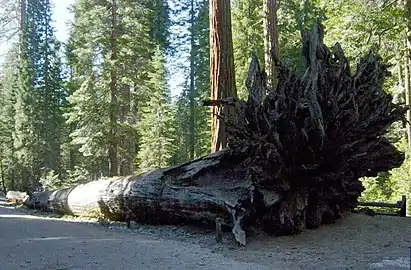Mariposa Grove
Mariposa Grove is a sequoia grove located near Wawona, California, United States, in the southernmost part of Yosemite National Park. It is the largest grove of giant sequoias in the park, with several hundred mature examples of the tree. Two of its trees are among the 30 largest giant sequoias in the world. The grove closed on July 6, 2015, for a restoration project and reopened on June 15, 2018.[1]
| Mariposa Grove | |
|---|---|
 Grizzly Giant tree of Mariposa Grove | |
| Map | |
 Mariposa Grove is located at the southern entrance to Yosemite National Park | |
| Geography | |
| Location | Yosemite National Park, California, United States |
| Coordinates | 37°30′50″N 119°35′54″W |
| Elevation | 5,740–6,730 ft (1,750–2,050 m) |
| Ecology | |
| Dominant tree species | Sequoiadendron giganteum |
The Mariposa Grove was first visited by non-natives in 1857 when Galen Clark and Milton Mann found it. They named the grove after Mariposa County, California, where the grove is located.[2]
The giant sequoia named Grizzly Giant is between probably 1900–2400 years old: the oldest tree in the grove.[3] It has a volume of 34,010 cubic feet (963 m3), and is counted as the 25th largest tree in the world. It is 210 feet (64 m) tall, and has a heavily buttressed base with a basal circumference of 28 m (92 ft) or a diameter of 30 feet (9.1 m); above the buttresses at 2.4 m above ground, the circumference is only 23 m. Grizzly Giant's first branch from the base is 2 m (6 ft) in diameter. Another tree, the Wawona Tree, had a tunnel cut through it in the nineteenth century that was wide enough for horse-drawn carriages and early automobiles to drive through. Weakened by the large opening at its base, the tree fell down in a storm in 1969.
Abraham Lincoln signed an Act of Congress on June 30, 1864, ceding Mariposa Grove and Yosemite Valley to the state of California. Criticism of stewardship over the land led to the state's returning the grove to federal control with the establishment of Yosemite National Park.
The Mariposa Grove Museum is listed on the National Register of Historic Places.
The grove was threatened by the Washburn Fire in July 2022.[4][5]
Noteworthy trees
Some of the trees in the grove are:
- The Fallen Monarch: A giant sequoia that fell more than three hundred years ago. Giant sequoias are resistant to decay, so their remains can linger for a long period of time if undisturbed.
- The Bachelor and Three Graces: A group of four giant sequoias, three of them growing very close together, with a fourth a little more distant. Their roots are so intertwined that if one of them were to fall, it would likely bring the others along with it.
- The Grizzly Giant: The oldest tree and second largest tree in the grove, with a volume of 34,010 cubic feet (963 m3).
- The Washington tree: The largest tree in the grove, with a volume of 35,950 cubic feet (1,018 m3).
- The General Sheridan tree: A large, 286 feet (87 m) tall giant sequoia located south of the Mariposa Grove Cabin.
- The General Grant tree: A large giant sequoia located west of the Mariposa Grove Cabin. Not to be confused with the General Grant Tree of Sequoia National Park.
- The Columbia tree: The tallest tree in the grove and in Yosemite National Park at 286 feet (87 m).
- The California Tunnel Tree: Cut in 1895 to allow coaches to pass through it (and as a marketing scheme to attract visitors to the grove), this is the only living giant sequoia tree with a tunnel in it since the fall of the Wawona Tunnel Tree in 1969 and the fall of the Pioneer Cabin Tree in 2017.
- The Faithful Couple: A rare case in which two trees grew so close together that their trunks have fused together at the base.
- The Clothespin tree: Countless fires throughout the decades nearly severed this tree's trunk, creating a space in it large enough for a pick-up truck to drive through.
- The Telescope tree: A giant sequoia tree that has become completely hollow from repeated fires through the decades. Despite that, the tree is still living, as giant sequoias do not require a whole trunk to survive. It is possible to walk inside the tree and, from there, see the sky. This condition leaves the tree weakened and makes it more difficult for it to withstand strong winds. This tree (and the Clothespin Tree) could topple at any time.
- The Galen Clark tree: Of historical importance, as it is said to be the first tree seen by Galen Clark when he entered the grove, and inspired his love for the giant sequoias and struggle for setting aside the land for preservation, a new concept in the mid-19th century.
- The Wawona Tunnel Tree: Renamed the "Fallen Tunnel Tree" after it toppled over during a snow storm in 1969. In 1881, this was the first tree to have a tunnel carved through its trunk. Its collapse is seen as a turning point in the preservation program in national parks in the United States. So grave was the shock of the tree's collapse that the result was a greater awareness of the sensitivity of ecosystems, even for a living thing as massive as the giant sequoias.
- The Fallen Giant: It was one of the largest trees in the grove, until it fell in 1873.
- The Massachusetts tree: It was one of the most famous trees in the grove. It fell in 1927.
Gallery
 Fallen Monarch, a fallen giant sequoia that is on the walking path leading to Grizzly Giant. (There used to be a parking lot near the Fallen Monarch, but Mariposa Grove has been reconfigured and there is no longer parking in that area.)
Fallen Monarch, a fallen giant sequoia that is on the walking path leading to Grizzly Giant. (There used to be a parking lot near the Fallen Monarch, but Mariposa Grove has been reconfigured and there is no longer parking in that area.)
 Group of sequoias known as The Bachelor and Three Graces.
Group of sequoias known as The Bachelor and Three Graces. California Tunnel Tree, the last living giant sequoia tunnel tree.
California Tunnel Tree, the last living giant sequoia tunnel tree. The Clothespin Tree
The Clothespin Tree The Mariposa Tree
The Mariposa Tree The Faithful Couple Tree
The Faithful Couple Tree The Mariposa Grove Cabin, located in the shadow of the General Grant (center) and General Sheridan (right) trees.
The Mariposa Grove Cabin, located in the shadow of the General Grant (center) and General Sheridan (right) trees.%252C_Yosemite_National_Park_(July_2023).jpg.webp) The Telescope Tree
The Telescope Tree Wawona Tunnel Tree, also known as the Fallen Tunnel Tree.
Wawona Tunnel Tree, also known as the Fallen Tunnel Tree.
Museum
Mariposa Grove Museum | |
 The Mariposa Grove Museum | |
 | |
| Nearest city | Wawona, California |
|---|---|
| Coordinates | 37°30′50″N 119°35′54″W |
| Area | 1 acre (0.40 ha) |
| Built | 1930 |
| Architect | National Park Service |
| Architectural style | Rustic |
| NRHP reference No. | 78000381[6] |
| Added to NRHP | December 1, 1978 |
The Mariposa Grove Museum, also known as the Mariposa Grove Cabin, is a large cabin built in 1930. It sits in the shadow of two prominent giant sequoia trees: General Grant and General Sheridan. It was listed on the National Register of Historic Places in 1978.[6][7]
The museum features numerous historic photographs and details the history of Mariposa Grove. Restrooms are inside.[8]
See also
- List of giant sequoia groves
- List of largest giant sequoias
- List of individual trees
- Nelder Grove - a nearby giant sequoia grove.
- Galen Clark - discoverer of the Mariposa Grove
- Guardian of the Wilderness - theatrical film about Galen Clark
References
- Mary Forgione (15 June 2018). "It's back to the big trees. Yosemite's Mariposa Grove of Giant Sequoias reopens after three-year restoration project". Los Angeles Times.
- Farquhar, Francis P. (1926). Place Names of the High Sierra. San Francisco: Sierra Club.
- Stephenson, Nathan L. (January 2002). "Estimated Ages of Some Large Giant Sequoias: General Sherman Keeps Getting Younger". Sierra Nature Notes. 2.
- Fernando, Christine (July 9, 2022). "Thick wildfire smoke hangs over Yosemite; flames reached notable giant sequoia grove". USA Today. Retrieved 9 July 2022.
- Westervelt, Eric (July 19, 2022). "Decades of 'good fires' save Yosemite's iconic grove of ancient sequoia trees". www.npr.org. NPR. Retrieved 26 July 2022.
The iconic grove of giant and ancient sequoia trees in California's Yosemite National Park is no longer under direct threat from the wildfire still burning through a southern section of the park and the nearby Sierra National Forest... foresters and ecologists say a half-century of intentional burning or 'prescribed fire' practices in and around the area dramatically reduced forest 'fuel' there, allowing the blaze to pass through the grove with the trees unscathed.
- "National Register Information System". National Register of Historic Places. National Park Service. July 9, 2010.
- Leslie Starr Hart (September 1975). "National Register of Historic Places Inventory/Nomination: Mariposa Grove Museum". National Park Service. and accompanying two photos and a map
- Park, Mailing Address: PO Box 577 Yosemite National; Us, CA 95389 Phone:372-0200 Contact. "Mariposa Grove of Giant Sequoias - Yosemite National Park (U.S. National Park Service)". www.nps.gov. Retrieved 2019-11-06.
Further reading
- Geology of U.S. Parklands: Fifth Edition, Eugene P. Kiver and David V. Harris (John Wiley & Sons; New York; 1999; page 227) ISBN 0-471-33218-6
External links
- Mariposa Grove of Giant Sequoias - Yosemite National Park
- Yosemite and the Mariposa Grove: A Preliminary Report, 1865, California State
- "Mariposa Grove", National Geographic Society
- Record from the 38th Congress, 1864 Act granting the grove to California
- Record from the 59th Congress, Act returning the grove to federal control
- Short radio episode Samoset about John Muir showing Ralph Waldo Emerson the Mariposa Grove, from The Life and Letters of John Muir, 1923. California Legacy Project.
